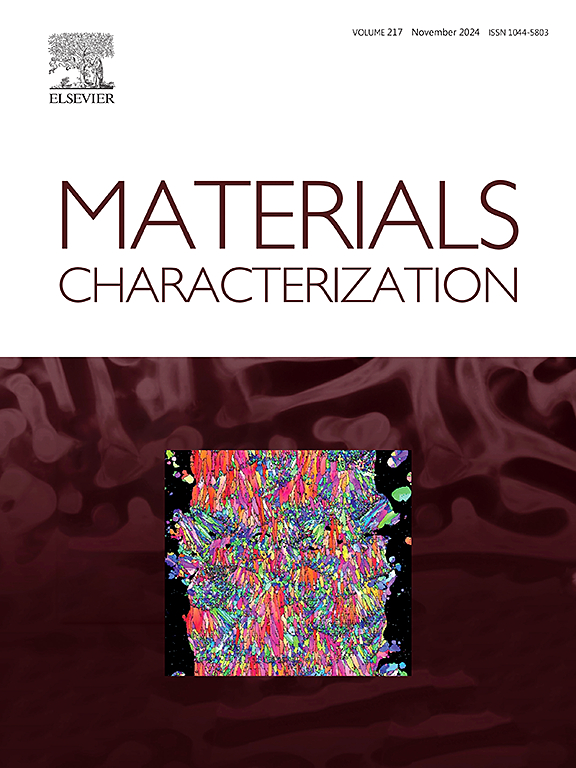The role of Ta in the microstructure evolution and high-temperature oxidation behavior of Inconel 625 superalloy fabricated by directed energy deposition
IF 5.5
2区 材料科学
Q1 MATERIALS SCIENCE, CHARACTERIZATION & TESTING
引用次数: 0
Abstract
Directed energy deposition (DED) holds great promise for fabricating Inconel 625 (IN625) superalloy components. However, issues such as grain coarsening and element segregation during DED processes pose significant challenges to the high-temperature oxidation resistance of IN625, especially at temperatures above 1000 °C. In the present study, Ta was incorporated into the IN625 alloy to fabricate the components with outstanding high-temperature oxidation resistance at 1100 °C via plasma arc DED. The influence of different Ta contents (0.2 wt%, 0.5 wt%, and 1.0 wt%) on the microstructure and high-temperature oxidation behavior at 1100 °C of DEDed IN625 were investigated. Results showed that with the increase of Ta content, the grains of IN625 were refined, and the precipitation of Laves phase reduced. Furthermore, it was observed that adding Ta remarkably decreased the oxidation rate of DEDed IN625 during the high-temperature oxidation testing at 1100 °C for 150 h. Compared to the IN625 sample, the mass gains of sample after the addition of 1 wt% Ta are reduced by 90.77 %. The refinement of grains and reduction in Laves phase allowed more Cr to transport to the oxidized surface to form a dense and protective Cr₂O₃ film during the initial stage of high-temperature oxidation. Subsequently, Ta atoms migrated to the Cr₂O₃ oxide layer/matrix interface, and combined with oxygen to form TaNbO5, which not only hindered the oxygen intrusion but also inhibited the outward diffusion of Nb, thereby preventing the formation of CrNbO₄ with poor adhesion to the matrix. Consequently, the oxidation rate was significantly reduced.
Ta在定向能沉积法制备Inconel 625高温合金组织演变及高温氧化行为中的作用
定向能沉积(DED)技术在制造因科乃尔625 (IN625)高温合金部件方面具有很大的前景。然而,在DED过程中,晶粒粗化和元素偏析等问题对IN625的高温抗氧化性提出了重大挑战,特别是在1000°C以上的温度下。在本研究中,将Ta加入到IN625合金中,通过等离子弧DED制备出具有优异的1100℃高温抗氧化性能的部件。研究了不同Ta含量(0.2 wt%、0.5 wt%和1.0 wt%)对DEDed IN625显微组织和1100℃高温氧化行为的影响。结果表明:随着Ta含量的增加,IN625晶粒细化,Laves相析出减少;此外,在1100℃高温氧化150 h时,发现Ta的加入显著降低了DEDed IN625的氧化速率,与IN625样品相比,加入1wt % Ta后样品的质量增益降低了90.77%。在高温氧化的初始阶段,晶粒的细化和Laves相的还原允许更多的Cr运输到氧化表面,形成致密的保护性Cr₂O₃膜。随后,Ta原子迁移到Cr₂O₃氧化物层/基体界面,与氧结合形成TaNbO5,既阻碍了氧的侵入,又抑制了Nb的向外扩散,从而阻止了与基体粘附性差的CrNbO₄的形成。因此,氧化速率显著降低。
本文章由计算机程序翻译,如有差异,请以英文原文为准。
求助全文
约1分钟内获得全文
求助全文
来源期刊

Materials Characterization
工程技术-材料科学:表征与测试
CiteScore
7.60
自引率
8.50%
发文量
746
审稿时长
36 days
期刊介绍:
Materials Characterization features original articles and state-of-the-art reviews on theoretical and practical aspects of the structure and behaviour of materials.
The Journal focuses on all characterization techniques, including all forms of microscopy (light, electron, acoustic, etc.,) and analysis (especially microanalysis and surface analytical techniques). Developments in both this wide range of techniques and their application to the quantification of the microstructure of materials are essential facets of the Journal.
The Journal provides the Materials Scientist/Engineer with up-to-date information on many types of materials with an underlying theme of explaining the behavior of materials using novel approaches. Materials covered by the journal include:
Metals & Alloys
Ceramics
Nanomaterials
Biomedical materials
Optical materials
Composites
Natural Materials.
 求助内容:
求助内容: 应助结果提醒方式:
应助结果提醒方式:


